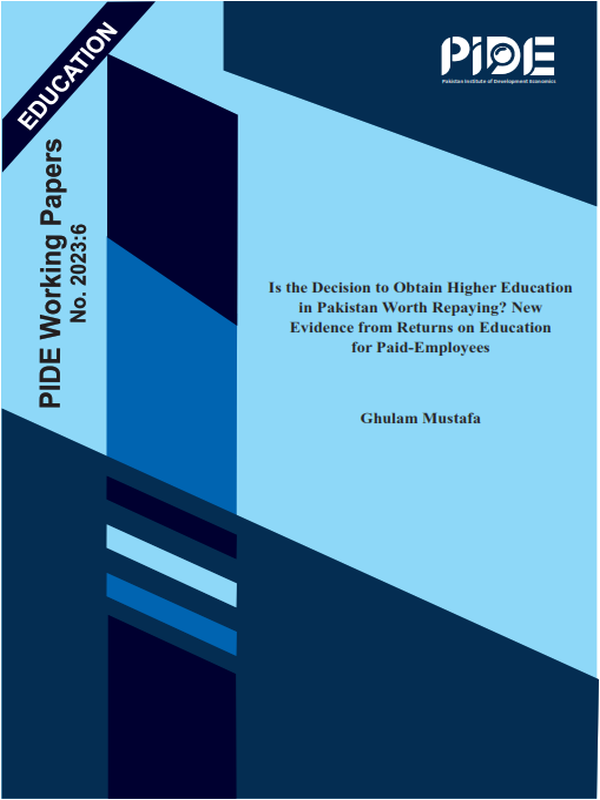
Pakistan Institute of Development Economics
- Home
Our Portals
MenuMenuMenuMenuMenuMenuMenu - ResearchMenuMenuMenuMenuMenuMenuMenu
- Discourse
- The PDR
- Our Researchers
- Academics
- Degree Verification
- Thesis Portal
- Our Portals
Is the Decision to Obtain Higher Education in Pakistan Worth Repaying? New Evidence from Returns on Education for Paid-Employees
ABSTRACT
The labour market in Pakistan has failed to absorb the labour force who have obtained degrees of higher education due to skill mismatch, over-supply of labour who have higher education, and low quality of higher education. In such context, a question arises whether a household’s decision to go for higher education is worth repaying or not. Therefore, the key objective of this research is to explore the returns on higher education that are declining relative to lower education in Pakistan. Moreover, the study has attempted to measure the non-linear relationship between schooling years and monthly wage. For the empirical purpose, all available rounds of Pakistan Social & Living Standard Measurement Survey (PSLM) datasets are employed. The Mincerian wage equation is estimated by applying Inverse Probability Weighting Regression AdJustment (IPWRA) and Instrumental Variable (IV) approaches to estimate said objectives. The findings obtained from IPWRA indicate that returns on higher education without professional degrees relative to the lower levels are falling at an increasing pace after 2010-11. Nonetheless, returns on professional degrees are increasing as compared to lower education. Similarly, IV results establish the non-linear relationship between schooling years, which demonstrate that after 2010-11, 12 years to 14 years of education is the optimum level. After these levels, returns on schooling years are falling. These striking results suggest that the government needs to focus more on promoting skills and development programs to enhance labour skills and the quality of education.
1. INTRODUCTION
Recent literature has been showing the decreasing returns on education against the huge amount of literature (Mamani-Choque, 2020; Psacharopoulos & Patrinos, 2018; Vecernik, 2013; Colclough, et al. 2010; Flabbi, et al. 2008; Fleisher, et al. 2005) which have suggested the increasing returns on education in developing countries. Doan, et al. (2018) have revealed that emerging economies are witnessing declining returns on education due to an over-supply of the educated labour force, skill mismatch, and changing structure and requirements of the labour market in these economies (Xie, 2020; Nieto & Ramos, 2017), while another strand of literature has argued the increasing returns on education due to the positive externalities of human capital. These positive externalities come by increasing the expenditures on research and development (R&D), knowledge creation through technological advancement, and enhancing the emerging skill requirement of the labour force is expected to expand the potential of workers which will result in increasing the returns on higher education owing to increase in the marginal productivity of the labour (Romer, 1990 & 1993). On contrary, workers with low adaptive and innovative capabilities are failed to learn quickly the usage of new technology due to poor skill development systems in their countries (ILO, 2015; Dicken, et al. 2006).
Pakistan is among those countries whose labour market is failed to produce decent jobs for its labour force. According to the Government of Pakistan (2018-19) , out of the total unemployed labour force, 78 percent are educated people, while 22 percent people are uneducated. On one side there is a huge rate of unemployment among educated people, especially among highly educated people who are facing a 20 percent unemployment rate. On the other hand, during the last couple of decades, enrollment in tertiary education is increasing overwhelmingly, new universities are being established without the provision of well-qualified teaching faculty and highly skilled human 1 resource to provide enough infrastructure in universities, and poorly designed incentive structures which are only producing several degree holders without equipping of marketbased
skills. Moreover, the design of the Pakistani labour market is not conducive to people having degrees of higher education (ILO, 2016). In nutshell, the education system of Pakistan has failed to produce quality human capital as World Bank (2018) has shown that Pakistan stands to hold the 134th position out of 142 countries on the quality of the human capital index. The learning outcome gap is found at 4.8 years which demonstrates that the human capital of the country is extremely poor. Similarly, Kemal (2005) has suggested that negligence of enhancement in human resources and insufficient measures to improve skill development is the main reason behind the low human development index. Another study conducted by Maclean, et al. (2013) has revealed that after Mongolia, Pakistan contains the second-lowest share of the total students enrolled in technical and vocational education and training.
____________
[1] http://www.pbs.gov.pk/content/labour-force-statistics



